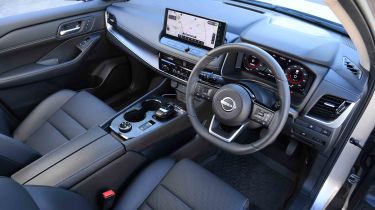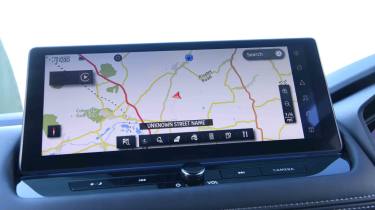Nissan X-Trail - Interior, design and technology
The Nissan X-Trail is bigger than before, while top-spec models feature impressive levels of onboard technology

With an increase in overall width and height, the fourth-generation Nissan X-Trail has a more imposing look than before. It has a genuine SUV feel compared with its smaller Nissan Qashqai sibling, and its sharper lines project a more aggressive stance.
There is a choice of ten body colours to choose from and, while the X-Trail suits a grey or silver hue, the Sunset Orange paintwork works well – particularly if you specify an optional two-tone black roof. If you don’t need seven seats, then a five-seat X-Trail costs £1,000 less than the equivalent seven-seater model.
If you want your X-Trail to have more of a premium air, then you’ll have to pay extra for either the Tekna, Tekna+, or N-Trek versions. Moving up to these top trim levels brings a power-operated tailgate with a hands-free function, quilted leather upholstery, a head-up display and a Bose audio system with ten speakers. The X-Trail’s standard 18-inch diamond cut alloys are fine, but the bigger, 20-inch versions that come with Tekna+ cars give the SUV a little more presence.
What is the Nissan X-Trail like inside?
Inside, the X-Trail has more in common with the Qashqai than Nissan’s more futuristic-looking Nissan Ariya EV, which means it does feel a little dated in the cabin.
Used - available now

2019 Nissan
X-Trail
47,905 milesAutomaticDiesel1.8L
Cash £15,100
2019 Nissan
X-Trail
60,171 milesAutomaticPetrol1.3L
Cash £16,100
2019 Nissan
X-Trail
36,550 milesManualDiesel1.8L
Cash £16,500
2019 Nissan
X-Trail
22,498 milesAutomaticPetrol1.3L
Cash £18,800Simple ergonomics take priority over flamboyant style in the X-Trail's cabin. We found the rather stubby gear selector easy to use and we like that it doesn’t take up much space on the centre console, while the climate controls are all chunky physical buttons and dials, not touch-sensitive sliders or plastic panels.
What is the interior quality like?
Quality is mostly good, and everything feels fairly well screwed together, however, so it's definitely a step up over the previous model, with plenty of squidgy plastics and well-damped buttons.
Sat-nav, stereo and infotainment
With the demise of the Visia trim every version of X-Trail comes with some form of touchscreen infotainment system. In Acenta Premium specification, there’s an eight-inch touchscreen, plus wireless Apple CarPlay, wired Android Auto, and a six-speaker audio systems. If you go for N-Connecta trim and above, you're rewarded with a 12.3-inch infotainment touchscreen (like the one fitted to the car pictured), while top-of-the-range models add a 10.8-inch head-up display.
Nissan has made some big steps with its infotainment systems in recent years, and while it’s not class-leading in any one area, the X-Trail's infotainment set-up is fairly solid across the board. We found the 12.3-inch screen in our test car was sharp and responded quickly when we tapped it. The menus are cleanly laid out, with a home display that shows three main widgets, and the navigation system is the largest of the trio.
There are a couple of physical shortcuts along the bottom of the screen, which make skipping tracks or radio stations easy on the move. The optional Bose sound system might be worth the extra £590 if you enjoy your music.









